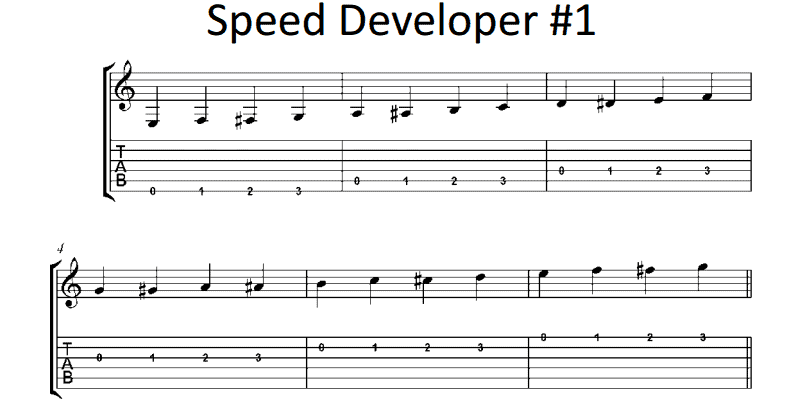- NOTATION
This exercise will help you to:
1. Develop strength
2. Accuracy
3. Confidence (which eventually will turn into speed)
Memorize this exercise first, then practice it slowly and accurately. Learn to place your finger right up next to the fret without actually placing it on the fret. This is the most efficient position to get a good clean note. Keep your hand relaxed. If you feel an excess of tension you can stop and shake out your hand. Paying attention to the small details now will save you a lot of time and anguish later.
Pay attention to your fingers.
You should be putting your finger close to the fret, but not on top of it. If your finger is placed too far back, the string is going to tend to buzz, but even if it doesn’t, you have to press really hard.
Now check the angle of your fingers. The closer you get to the fret, the less pressure it takes to make good, solid contact.
When you put the second finger down, keep your first finger down as well. Get your fingers as close to the fret as possible so you train your fingers to stretch a little bit. Do the same thing for the 3rd fret.
You want to keep your thumb roughly in the middle of the neck. And have your fingers angled so they’re going as much as possible up. and then down. If you open your hand more, it takes a lot more strength to press the fingers down. As long as you go up and then down against the fretboard, it takes less pressure so actually, it’s easy.
You want to get to where if you let your hand go just slightly, it will just fall off the guitar. Use just enough pressure to hold the guitar there and make the strings sound.
Start as slowly as you need to go. You can always pick up speed little by little. Take your time to get into the right place, this is for you.
Give it a shot!
- 6th String: Open, First finger, Second Finger, Third Finger
- 5th String: Open, First finger, Second Finger, Third Finger
- 4th String: Open, First finger, Second Finger, Third Finger
- 3rd String: Open, First finger, Second Finger, Third Finger
- 2nd String: Open, First finger, Second Finger, Third Finger
- 1st String: Open, First finger, Second Finger, Third Finger
Now, if you’re just learning this exercise and you’re just beginning guitar, be sure to go slowly, placing one finger down at a time.
If you’ve been playing for a while and this exercise seems to be coming along, you want to start doing it with a set tempo. I like to use a metronome but start by counting out loud, keeping a steady pulse.
Before you do that, you want to make sure that you practice getting your fingers in the right place.
I encourage you to do this exercise every day, at least for a while, and probably come back to it from time to time. I still do a version of this exercise myself!


How long do you thing a guitar should the tune?
I bought my beginner “Ortega R122L”…the only lefty guitar I found, and I have to tune it every day I play.
Is this normal?
Thanks
Congratulations on your guitar Christian! It is normal. Especially nylon strings.
I tune mine every time I sit down to practice. The good news is that after a while, it gets so easy to tune from experience that you don’t think about it.
Really hard for me to finger on the low E string. I have very small numbers hands
Hi Tami. Thanks for commenting. If it’s too difficult you can skip the low E for now and add it back as you get more experience. The most important thing is to do this every day even for a few minutes. It will get easier over time.